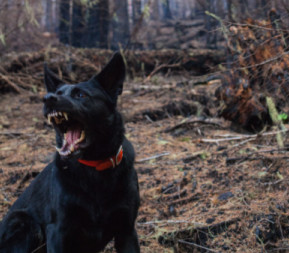What is the Keelut?
This creature is an Inuit legend, one who hunts people during the winter, but it’s not actually a predator in the strictest sense–it’s a spirit of the Netherworld. The Keelut (key-loot), also known as the Qiqirn (key-kern) is sometimes referenced as a spirit of death or an evil earth spirit. While it is actually a spirit, it takes the form of what some believe to be a true cryptid. To be honest, it’s hard to say which is a more frightening aspect of this creature, that it’s an immense, malevolent, black, hairless dog with the sole purpose of preying upon humans, or that it’s also a spirit so it doesn’t necessarily abide by the laws of physics. The Keelut’s mythological cousin is the Church Grim or Barguest of Great Britain, who stalks those traveling in the night which results in an untimely death.
The major difference between the Church Grim and the Keelut is the fact that the Keelut doesn’t have any hair, except for on its feet. They say that this makes their tracks in the snow disappear easily, which gives the advantage of stalking prey without being noticed. Aside from their predatory nature, these creatures have other similarities that transcend the separation of culture—both are known to act as a harbinger of death, and otherwise feast upon the dead. In Inuit folklore, the Keelut is known to attack lone travelers, the sight of one would cause disorientation, then eventually hypothermia and death.
Hold the Dark (2018): Bringing Alaskan Horror Legends to Life in a New Way
This Alaskan creature of terror was made to take the sidelines in William Giraldi’s book Hold the Dark: A Novel (2014) and now a Netflix original film Hold the Dark (2018) when the residents of Keelut, a remote (fictional) Alaskan village, have been the unfortunate targets for a dangerous pack of wolves. These wolves have successfully taken three children before the main story takes place. It’s certainly a spin to the original tale of the Keelut, but it pays special homage to the Inuit folklore wherein it was born.
While it certainly didn’t get rave reviews from this critic, I have a personal bias when it comes to films that include Alaska and the surrounding culture, even if it’s not terribly accurate.

Georgia-based author and artist, Mary has been a horror aficionado since the mid-2000s. Originally a hobby artist and writer, she found her niche in the horror industry in late 2019 and hasn’t looked back since. Mary’s evolution into a horror expert allowed her to express herself truly for the first time in her life. Now, she prides herself on indulging in the stuff of nightmares.
Mary also moonlights as a content creator across multiple social media platforms—breaking down horror tropes on YouTube, as well as playing horror games and broadcasting live digital art sessions on Twitch.


